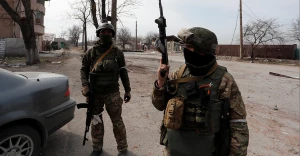
Ukraine charges four Russian guardsmen who tortured residents of Kherson – The New York Times
The four acted with impunity, beating prisoners relentlessly and torturing them with electric shocks, waterboarding and mock executions
In a detailed news story The New York Times reports about the mass tortures inside Kherson’s detention centers.
According to the article, Russian captors subjected prisoners to relentless beatings and torture methods like electric shocks, waterboarding, and mock executions. The detention center in southern Ukraine, housing 200 detainees, was controlled by Russians who showed little concern for hiding their identities. Ukrainian prosecutors recently filed war crimes charges against four members of the Russian National Guard, including the facility's commander and three subordinates. These individuals face charges of cruel treatment of civilians and violations of war laws.
The article says that the case is among the first to result from extensive investigations in Kherson, the region occupied by Russian forces for over eight months. Investigative efforts have uncovered numerous crimes committed during the occupation, including executions, deaths in custody, torture, sexual violence, and severe beatings.
It is noted that within the Kherson region, authorities have discovered 11 detention facilities with torture chambers, where both men and women suffered abuse. The four individuals charged with war crimes supervised the pretrial detention center at Thermal Energy Street in the center of Kherson. Victims of the Russian National Guard identified them from photographs, and several of these victims spoke with journalists in Kyiv last week, facilitated by prosecutors.
Three individuals, two men and one woman, died at the facility. Investigators revealed that the men were subjected to physical abuse, while all three were denied healthcare. Shockingly, 17 detainees reported experiencing sexual torture involving electric shocks to their genitals, investigators said.
The four Russians facing accusations are Colonel Aleksandr Naumenko from Rostov-on-Don, Aleksandr Bocharov from the Krasnodar region, Anver Muksimov from Stavropol, and Aleksandr Chilengirov from the Orenburg region.
Established in 2016 by President Vladimir V. Putin, the National Guard serves as Russia's internal security force, separate from the Armed Forces. It directly reports to the president.
Investigators identified the National Guard unit involved through information provided by Ukraine's intelligence service, telephone intercepts, and witnesses. The acts of violence were often gratuitous, inflicted during interrogations to coerce false confessions. Andriy Kostin, Ukraine's prosecutor general, likened the methods used to those employed by secret police during Joseph Stalin's purges.
The New York Times shares a story of Oleksii Sivak, a 38-year-old Ukrainian seaman turned activist, who was arrested in August. He endured beatings and electric shocks, including to his genitals, during interrogations. Sivak managed to identify at least one of the accused individuals. In an interview in Kyiv, he described a brutal interrogation method involving electric shocks and physical abuse. The shocks lasted for about an hour with only short breaks, administered by multiple individuals using a dynamo machine. At one point, a pistol was held to his head to force a confession. He could identify his captors as they briefly removed his blindfold. Despite others wearing masks, one guard who escorted him to the torture chamber did not bother to hide his face, allowing Mr. Sivak to identify him.
Another victim, Mr. Shapovalenko, suffered similar torture, including beatings, stabbing, and waterboarding. The most excruciating pain came from electric shocks to the earlobes, causing him sleeplessness and visual hallucinations.
Ihor, a cellmate of Mr. Shapovalenko in his 50s, died from severe beatings after being interrogated for several days. The guards prevented him from sleeping and forced him to write a statement. Although they allowed him to sleep on the fourth day, it was too late, and he died that night.
Serhii Ruban, a 42-year-old sales consultant, also died in the detention center. Witnesses saw him being heavily beaten, and his body was found in a mass grave with multiple rib fractures. His mother identified him by a tattoo on his knuckles and confirmed that he was beaten to death.
Both deaths have left the inmates traumatized and fearing for their own lives, the article concludes.
- News














































